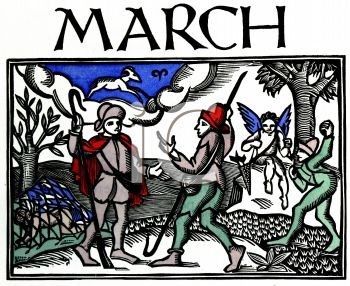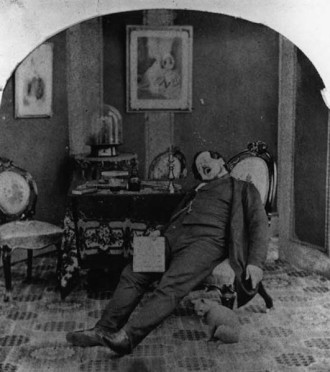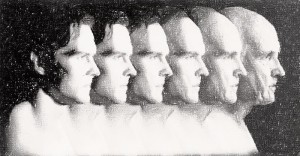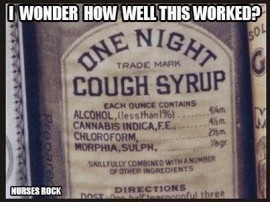Nap 3 24 13
Nap
And mamma in her 'kerchief and I in my cap
Had just settled down for a long winter's nap.
-Account of a Visit from St. Nicholas
How I do appreciate my nap. Ask anyone that knows me. I love that nap. As grumpy as I am, without that blissful hour (or two) I am not good company. How about you?
I guarantee you I am not the first. The very word nap enters our language as the Old English ‘hnappian’ and its Chaucerian English ‘nappen’ where it refers to periods of sleep either long or short. A Middle English translation of Psalm 121 verse 4, ‘Behold, he that keepeth Israel shall neither slumber nor sleep,’ reads as ‘Loo, ha shal not nappen ne slepen that kepeth ireal.’
The Romans felt the afternoon nap a necessity not a luxury. The siesta originates in Islamic Law and is found in the Koran. The Spanish word siesta comes from the Latin ‘Hora Sexto’, the sixth hour from dawn’, the midday rest. For them it began as a time for farmers to rest during the hottest part of the day.
Today, air conditioning seems to make naps not needed. Even Spain makes less of it keeping more with northern Europe. This does not mean we do not need a short rest. This need – this biological need – for a short rest applies to all humans. Humans are mammals, like any cat, horse or dog. We are ‘biphasic’ and need more than one sleep time in each 24-hour period. Natural tiredness occurs about 8 hours after waking like it or not. All mammals nap. Only we among mammals struggle against it. Only we refuse this one break we can get to restore energy levels and productivity.
Many famous people nap.
As a good Texan, my favorite napper is Santa Anna rumored to be at siesta when Sam Houston attacked him at San Jacinto winning Texas independence. My least favorite, of course, is that poor Texan sentinel napping when Santa Anna stormed the Alamo.
The energetic Napoleon Bonaparte could fall asleep at the drop of a hat even before a battle and during artillery barrages.
Stonewall Jackson, like Napoleon, napped by fences, under trees or porches, and while his troops fought McClellan. A Dr. Hunter McGuire says on many long night marches he held Jackson’s coattail to keep him on his horse as he napped.
Artist Salvador Dali took one second naps he called ‘slumber with a key’. He’d sit in a chair, placed an overturned plate on the floor between his feet, and pressed a key between thumb and forefinger. The moment he slept the key dropped and hit the plate. He awoke ‘revived’. Einstein and other inventors and thinkers claim similar napping strategies. The war hero Audie Murphy kept himself from dropping off on guard duty holding a pistol that would drop on his foot waking him in his foxhole.
Winston Churchill’s nap was ‘non-negotiable’. As a self-professed night owl, Churchill believed naps doubled his productivity. He even kept a bed in the Houses of Parliament.
Ronald Reagan, John Kennedy, Lyndon Johnson and Bill Clinton all napped in the Whitehouse. John D. Rockefeller napped in his office. Gene Autry napped in his dressing room. TV personality Jenny McCarthy napped. Erin Murphy, ‘Bewitched’ daughter Tabitha, napped on set. Antonia Will, PhD. Head of Chronobiology napped between appearances on Rosie, Oprah, Letterman and Late Night with Conan O’Brien all on the same day.
Besides keeping me a married man and generally making me better company, the greatest benefit of napping is breaking up a huge bout of writer’s block, which is why this piece is getting on my blog.
No day is so bad that it can't be fixed by a nap.”
― Carrie Snow
When you can't figure out what to do, it's time for a nap.
― Mason Cooley
Inspiration 3 11 13
Being world-weary and feeling all dried up I went looking for a reboot – for some inspiration. Yeats is good for that. He, to me, is among the writers’ poets and carries the spark of what the Celts term ‘awen’, the gift of the ‘breeze’ causing poetry to flow from their mouths. This ‘breeze’ or breath is given from the gods. So, Yeats is a good place to start when looking for that breeze – to have prose flow on to the paper.
He first tells me: ‘The world is full of magic things, patiently waiting for our senses to grow sharper.’ I believe him and wait with the world for those magic things. Recently, my characters whispered that magic in my ears when my senses rang dull by doctors, bankers, and life’s grudging business. Sometimes, however, a good movie, a good book, or a dropped comment can do it. Oak trees, sunsets, and thunderstorms do it too.
Breathe in this universal breath and see the magic things. After that, we can do two things:
‘Let us go forth, the tellers of tales, and seize whatever prey the heart long for, and have no fear. Everything exists, everything is true, and the earth is only a little dust under our feet.’ And, make ‘the world to be a grassy road before her wandering feet.’
It sounds, of course, deceptively simple. Just seize the story fearlessly and make a world for our characters to tread. The characters, created real enough, should then tell their stories to us. We then dutifully data process the story (they used to say ‘transcribe’) onto paper or onto computer screen. There is a bit more work involved, I fear.
Yeats has one more point to consider as we work. It is probably the most salient point to me, and the hardest to practice:
‘Think like a wise man but communicate in the language of the people.’
All the things we learned about language, sentence structure, and logical argument, and organization come into play here. Keep it simple. Don’t use a big word when a simple one will do. Use topic sentences. Don’t ramble. When you find something you wrote is grand – strike it out. If it doesn’t further the story – strike it out. And, my favorite, there is no such thing as writing there is only rewriting.
I take one final thought in my journey toward inspiration as I near my birthday of advanced years: ‘but one loses, as one grows older, something of the lightness of one's dreams; one begins to take life up in both hands, and to care more for the fruit than the flower, and that is no great loss perhaps.’ Let us, as writers, look to the fruit and not always the flower of what we write.
Boomer 3 5 13
My goodness, will you look at the hour? Actually, look at the decade right after looking at my birth certificate. I am a ‘Boomer’. I am a product of soldiers coming home from war eager to begin lives. Time, it seems, marched me, and my peers, right into our sixth decade. Our sixth! We are in the middle of dealing with all the business of reaching that sixth decade.
Tom Brokaw, in his amazing book, The Greatest Generation, defined that generation: ‘it is, I believe, the greatest generation any society has ever produced because they fought not for recognition, but because it was the right thing to do then they built America into a superpower’. They also built the largest population ‘boom’ in the history of the world. That’s us. Beginning almost exactly nine months after war’s end and lasting until 1964, historian Landon Jones said: ‘the cry of the baby was heard across the land’. My Dad returned from occupying Eastern Europe in 1946, married in 1947, and nine months and three days later, I was born. By the time it was over, 76.4 million ‘baby boomers’ graced the face of the nation. We lived, we loved, we rebelled, and then many of us settled down to make our own families. After that, we aged. The passing of generations is a business of the sixth decade.
In our faces and mirrors, the houses and trailers of my friends and family, our banks, our graveyards, even along the sides of our roads, are the signs of this aging. There are signs of change – the only constant in the universe that I see. The signs of change are a business of the sixth decade.
I see a reflection in the mirror. What happened to that baby-faced child? No nips/tucks but I know those that have some. And, God, what is that thing jiggling under my chin? Everyone I know is getting some snow up there. I feel blessed that I still have just enough hair there to hold it. Still, there is less and less. Changes in that reflection are a business of the sixth decade.
That mirror sits on the wall of a tolerably nice house. A certain amount of affluence came with our efforts over the years. My poorest friend manages to live with his sister. My next poorest friend owns his own trailer. We all have lots of toys. The toys reflect the benefits of modern technology. It is not the technology of our parents, the Greatest Generation; it is the technology of the Boomers. Rip Stop nylon, DVDs, video games… Toys are a business of this sixth decade.
That mirror reflects my aging. That reflection causes me to reflect. The ‘Greatest Generation’ is passing. All of my friends have lost one or both their parents. My mom lies in a sparse lonely graveyard that would remind you of one in a Clint Eastwood western. My cousins buried their father years ago. I have one friend whose mother’s ashes sit in a spare bedroom waiting for the day she has time to go where she wants to scatter them. My poorest friend lost both parents and still fights with his sister over the dregs of the small estate. I’ve lost friends in Vietnam. I’ve lost friends to the drugs of the sixties. I’ve lost a friend to the drug war – the police cutting loose after the fool robbed a drug store. Death is a business of the sixth decade.
Medicare reaches out for us. Society ponders taking care of us in our twilight years. The right decries our worth. The left exalts it. Radio stations and commercials play our music. The medical industry sucks away at our discretionary income. We sit around reminiscing and giggling over our ‘glory days’ as the calendar turns its pages. And still, who is that guy in the mirror dealing with the business of the sixth decade?
Cure 3 1 13
"The cowards never started and the weak died on the way."
-Anonymous
Men and women had to be tough to survive on the American Frontier. Not only did they contend with the elements and the bad guys they fought disease. They fought disease any way they could, often in very creative ways.
William Burns Malone, civil war veteran, farmer, and itinerate sheepherder gave his Small Pox and Scarlet Fever cure in the late 1800’s. He generously shared his cure. Anything to help for death came easily to the frontier.
From ‘DOCTORS, HEALERS, and HEALTH
The State of Medicine in the Old West:
…reported causes of death included consumption, freezing, fever, pneumonia (these were the four commonest), croup, dropsy, acute diarrhea, cancer, diphtheria, gunshot wounds, cholera, lung fever, bronchitis, fits (the 10 next commonest), suicide by drowning or poisoning, drowning in a well, dysentery, congestion of the brain, spasms, erysipelas, bilious colic, apoplexy, inflammation of the liver, and knife wounds. Ten years later the list was topped by diphtheria and consumption, besides "struck by lightning," St. Vitus' dance, teething(!), "kicked by a horse," gravel, worms, inanition, alcoholism, "struck by a falling body," calculus (presumably not the mathematical kind), scalding, asthma, "gored," sunstroke, hanging (whether official, accidental, or suicidal is unspecified), heart disease, suicide by hanging, endocesditis, "killed by Indians," and "shot while sparking another man's wife."
William, called ‘Burns’, contributed his dose to an unnamed California newspaper:
"A SMALLPOX CURE"
By W. B. Malone
To the News: I send the following recipe from a California correspondent, which is said to cure for the dreaded contagion, smallpox: 'I herewith append a recipe which has been used to my knowledge in hundreds of cases of smallpox. It will prevent or cure, through the pittings or filling.' When Jenner discovered the cow pox in England the world of science overwhelmed him with fame but when the scientific school of medicine in the world, that of Paris, published this recipe, it passed unheeded. It is as unfailing as fate, and conquers in every instance. It will also cure scarlet fever. Here is the recipe as I have used it to cure smallpox:
1 gram Sulfate of Zinc
1 gram Digitalis
1/2 teaspoon Sugar
Dissolve in a wine glass of soft water or water which has
been boiled and cooled. Take a teaspoon full every hour.
Either smallpox or scarlet fever will disappear in twelve
hours. For children, the dose must be diminished according
to age. If Countries would compel their Physicians to use
this treatment there would be no need of pesthouses. If you
value your lifer use this recipe."
I'm sorry no date appears on this recipe. I would guess the late 1800's. Smallpox was a deadly disease when it hit the new world. Not only did it kill many whites but it decimated Indian tribes. Burns would appreciate that, in 1994, smallpox has been eradicated from the earth.
(Burn’s cure is found in a family history written by his grandson, Ira E. Malone, Jr.)






